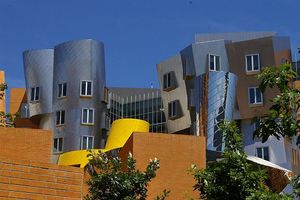The city of Boston is known around the world as a center of academic life in America. This is due in part to the estimated quarter million college students attending dozens of colleges and universities in and around the city. It is also due to the rich history and storied academic reputations of schools such as Harvard and the Massachusetts Institute of Technology.
Among the dorms and labs and research centers of the universities in the Boston area are some famous college landmarks. These places are known for their architectural importance, their fabled histories – even the legends that define them.
Memorial Hall – Harvard
After the Civil War, a group of Harvard alumni decided to erect a memorial to students and graduates who had fought to preserve the Union. The project was eventually combined with an alumni-endowed plan to build a theater on campus for Commencement exercises and other events. After more than a dozen years of planning and construction, Memorial Hall – and the Sanders Theater within the building – was opened. The hall contains the marble busts and paintings of many prominent figures in Harvard history, as well as a magnificent collection of stained glass. The beautiful theater is renowned for its acoustics and its unique 180-degree layout.
Stata Center – MIT
The MIT campus is well-known for its architecture. MIT was the first school of architecture in America, and has a history “stretching the envelope” when commissioning new buildings. There is perhaps no better example of this than the Frank Geahry-designed Building 32, which houses many computer science and electrical engineering classes. Opened in 2004, the building utilizes a wide variety of exterior finishes, and its seemingly-jumbled angles and curves were controversial. More than one observer remarked that the entire building appeared to be falling down.
Shelton Hall – Boston University
Built in 1923 as a hotel, Shelton Hall was converted to dormitory space when Boston University purchased the building thirty years later. In its last days as a hotel, however, playwright Eugene O’Neill – the Nobel-winning author of such classics as Long Day’s Journey Into Night and The Iceman Cometh – died in Room 401. Ever since, students have claimed that the room, and much of the fourth floor, is haunted by O’Neill’s ghost. Lights in the hallway – known as Writer’s Corridor – dim and elevators reportedly stop randomly at the fourth floor.
Massachusetts Hall – Harvard
Built as a dormitory nearly 300 years ago, Massachusetts Hall is the oldest building still standing in the college’s original Harvard Yard. Through the years, political leaders, captains of industry and major societal figures have called the building home. John Adams, second president of the United States, lived there, as did his fellow Revolutionary War patriots John Hancock and Samuel Adams. During the siege of Boston in the early days of the war, colonial soldiers were barracked there. Today, freshmen students still live on the upper floors, while the office of the University’s president is located downstairs.
